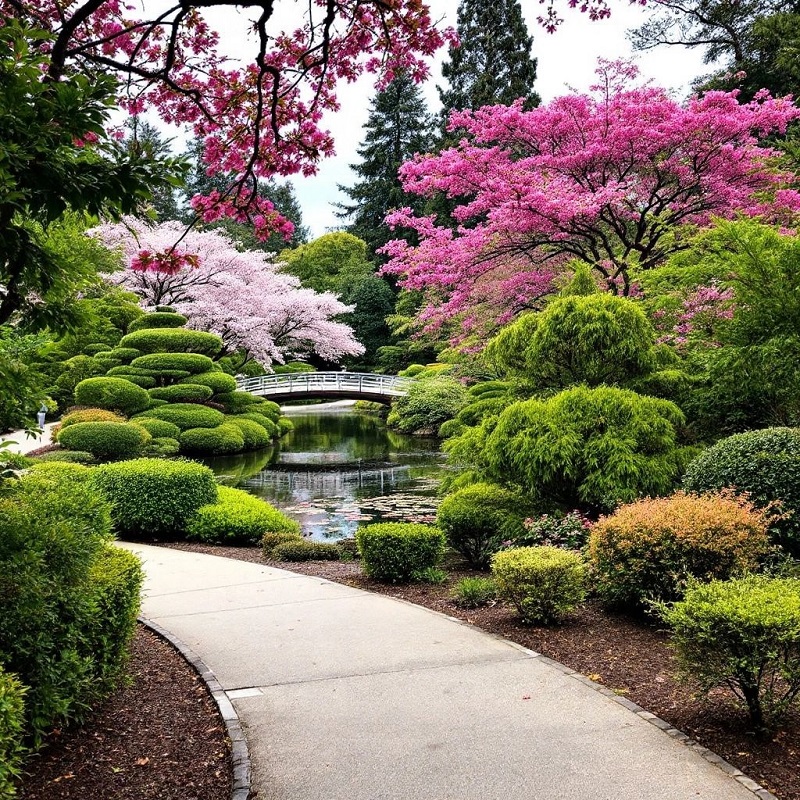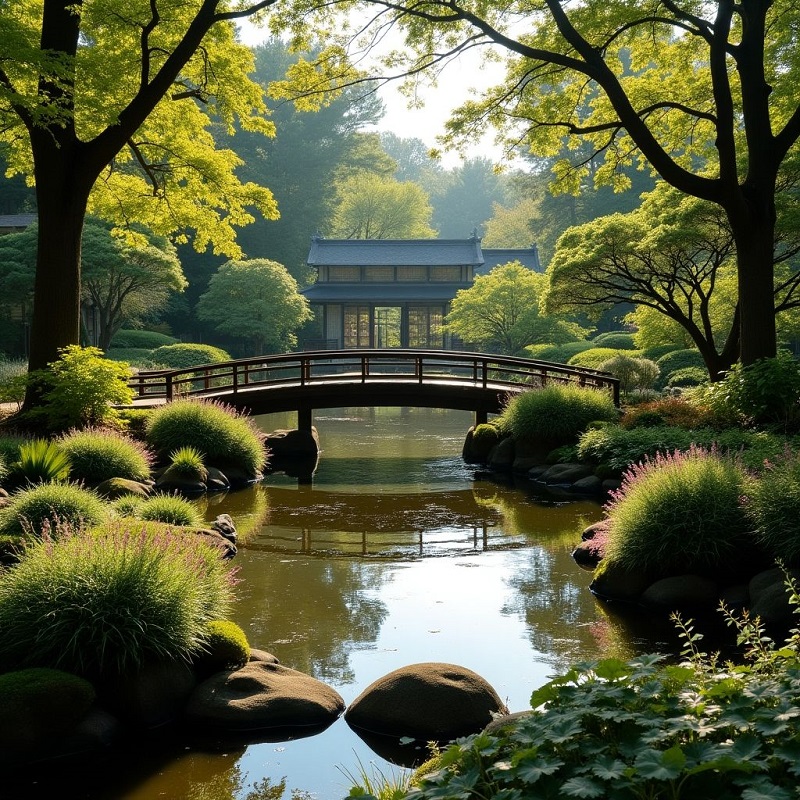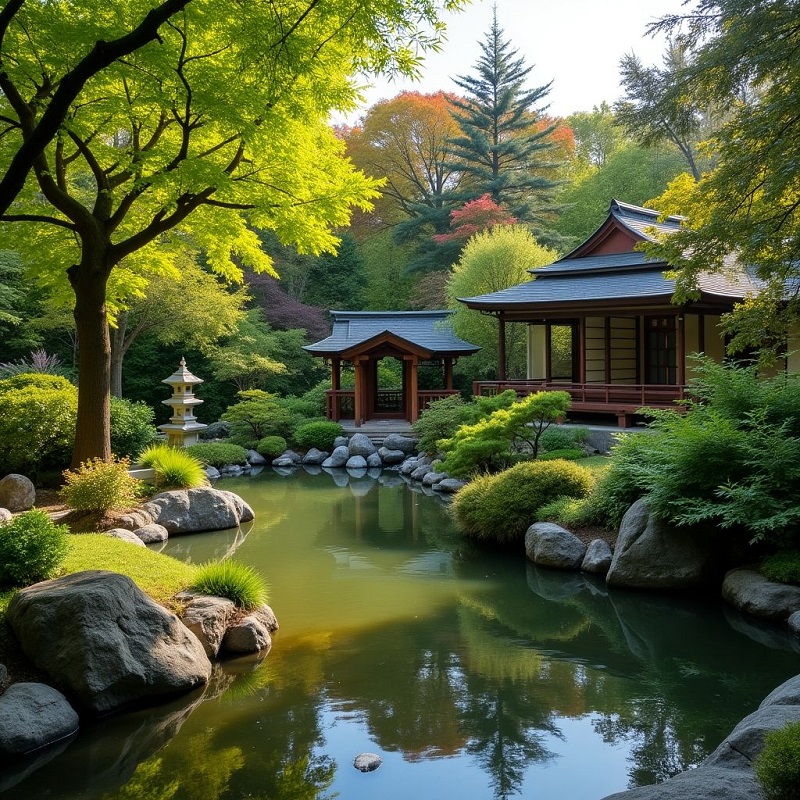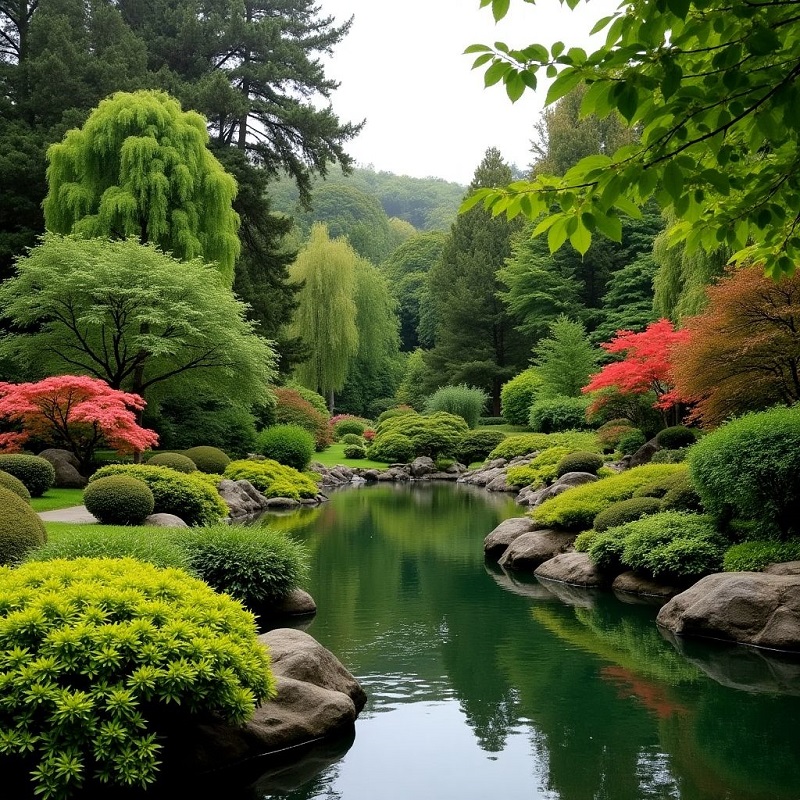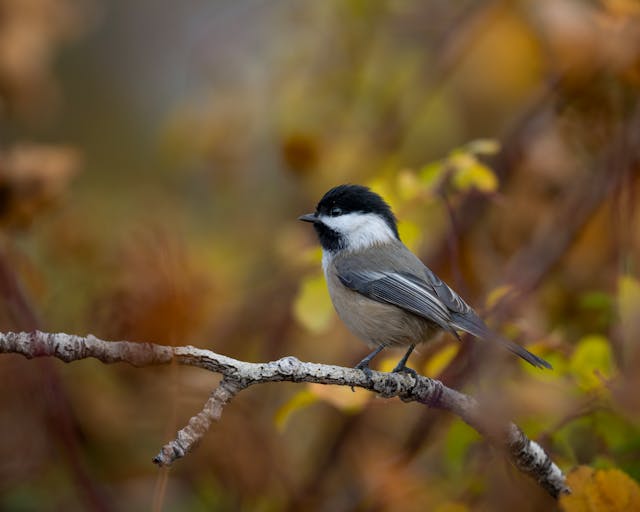The San Mateo Japanese Garden is a hidden gem in the middle of Golden Gate Park. This isn’t just a place to chill; it’s a history, culture, and landscape extravaganza. From the traditional Japanese buildings to the seasonal flowers, the garden is an experience that combines nature and art. Walk the peaceful paths or attend a cultural event and the San Mateo Japanese Garden welcomes you in.
Highlights
- Oldest Japanese public garden outside of Japan, established in 1894.
- Traditional Japanese buildings, including a 5 story pagoda and a beautiful Drum Bridge.
- Designed with Japanese landscaping principles: harmony with nature and water features.
- Seasonal beauty: cherry blossoms in spring and fall foliage in autumn, every visit is different.
- Cultural events: tea ceremonies and art exhibitions.
About the History of the San Mateo Japanese Garden
Beginnings and Inspiration
The San Mateo Japanese Garden has a long history dating back to the late 1800s. It was during this time that Japanese sojourners and pioneers came to San Mateo County from Imperial Japan. They brought with them their customs and love of nature and this garden was born. It’s a nod to their legacy and traditional Japanese landscapes.
People Involved
One of the key people behind the Japanese garden in San Mateo was a local landscape architect who wanted a space that would combine nature and design. His passion for preserving Japanese gardening techniques has made the garden a beloved landmark in the community. His vision still guides the garden’s maintenance and design today.
Timeline
Over the years the garden has undergone several changes, each adding to its character and importance. Notable milestones include the introduction of plants that symbolize peace and serenity, traditional structures and cultural events and the garden has become a community gathering place. Today it’s a reminder of the beauty of Japanese gardens and how they can bring peace and quiet to our busy lives.
Garden Features
Japanese Structures
The San Mateo Japanese Garden has several traditional structures to admire. One of the most impressive is the 5 story pagoda built for the Panama Pacific International Exposition in 1915. This beauty stands tall and invites you to take a closer look. The front gate, no nails, is another wonder of Japanese craftsmanship.
Design Elements
Every detail in the garden was designed to create a peaceful space. Natural materials and placement of structures are based on Japanese design principles. For example the Drum Bridge with its crescent shape is a great spot for photos and adds to the serenity of the garden. The 9,000 pound bronze Lantern of Peace is a calming presence and symbol of friendship between America and Japan after World War II.
Nature Connection
The garden’s architecture is not just about buildings; it’s about how those buildings relate to the surroundings. The paths wind through the greenery so you can get up close and personal with nature. The 200+ year old Buddha statue is a spiritual presence and invites reflection and peace. The integration of architecture and nature creates a peaceful oasis and is the perfect escape from city life.
List of notable species found in the garden:
Trees:
- Japanese Maple (Acer palmatum) – Known for its vibrant fall foliage, this tree adds color and texture to the garden.
- Cherry Trees (Prunus serrulata) – Famous for their beautiful spring blossoms, these trees are a highlight during cherry blossom season.
- Pine Trees (Pinus spp.) – Sculpted pines symbolize longevity and strength in Japanese gardens.
- Cypress (Chamaecyparis spp.) – Adds a graceful evergreen presence, often trimmed into unique shapes.
Plants and Shrubs:
- Azaleas (Rhododendron spp.) – These flowering shrubs provide vibrant blooms, often shaped into rounded forms.
- Camellias (Camellia japonica) – Known for their glossy leaves and showy flowers, they add elegance to the garden.
- Bamboo (Phyllostachys spp.) – Used for fencing and creating a serene, traditional Japanese ambiance.
- Bonsai Plants – Miniature trees meticulously pruned to reflect the beauty of larger landscapes【12】.
Water Features:
- Water Lilies (Nymphaeaceae) – Found in the koi pond, they enhance the tranquil aquatic environment.
Ground Cover and Ornamentals:
- Moss (Bryophyta) – Commonly used for natural-looking ground cover, symbolizing age and serenity.
- Iris (Iris ensata) – Often planted near water features for their elegant, colorful blooms.
Additional Features:
The garden also includes koi ponds and carefully raked gravel in Zen-style elements, contributing to the peaceful atmosphere.
Japanese Landscaping
Japanese Garden Design Principles
Japanese gardens are designed to be in harmony with nature. The layout reflects the natural landscape using rocks, water and plants to create a peaceful space. The placement of these elements encourages you to walk around the garden and experience it from different angles and connect with nature.
Water Features
Water is a key element in Japanese landscaping, symbolizing purity and calmness. Ponds, streams and waterfalls are placed strategically to create sounds and reflections. They not only beautify the garden but also attract wildlife and add to the ecosystem. For example using river rock to create dry riverbeds can add to the beauty of the garden and be a low maintenance solution.
Plant Symbolism
Plants in Japanese gardens are chosen for their symbolic meaning and seasonal beauty. Each plant has a purpose, whether it’s to represent strength, resilience or beauty. For example cherry blossoms represent the fleeting nature of life, evergreens represent endurance. This thoughtful selection means the garden changes with the seasons and offers a different experience every year.
Seasonal Beauty and Botanical Diversity
Spring Blooms and Cherry Trees
As spring arrives the garden comes alive with color. Cherry trees bloom and create a pink canopy that attracts many visitors. The scent of fresh blossoms fills the air and it’s a great time for photos and strolling.
Summer Loveliness and Green
Summer is when the garden is in full bloom and full of life. The greenery San Mateo Japanese Garden is at its best and it’s a cool escape from the heat. Visitors can sit in the shade of ancient trees, some of the oldest in San Francisco, and enjoy the garden’s character. The colors of the flowers and plants are beautiful.
Autumn Colors and Foliage
As autumn approaches the garden is a riot of reds, oranges and yellows. The changing leaves create a warm atmosphere and an excuse to sit and appreciate the beauty of nature. This is a special time of year as it shows off the garden’s botanical diversity and is a favorite time of many to visit.
Events and Activities
a variety of events and activities throughout the year, including koi feeding sessions, seasonal festivals, and cultural events tied to its Japanese heritage. Here’s a summary of available information:
- Koi Fish Feeding: Visitors can enjoy watching the koi fish feed daily during the summer at 11:00 AM and 3:00 PM. This is a delightful experience for families and garden enthusiasts.
- Annual Events: Central Park, home to the garden, features community events like the Central Park Music Series and the Eggstravaganza, though the specific involvement of the Japanese Garden in these is not detailed.
- Cultural Significance: The garden reflects the sister city relationship between San Mateo and Toyonaka, Japan, hosting Japanese cultural elements such as traditional architecture and horticulture. Seasonal blooms like cherry blossoms in spring draw visitors.
Tea Ceremonies and Workshops
The San Mateo Japanese Garden hosts traditional tea ceremonies where visitors can experience Japan’s culture. These are not just about drinking tea; they are a meditative practice that emphasizes harmony and respect. Participants can learn about the history and significance of tea in Japanese culture while sitting in the peaceful garden.
Art Exhibits and Performances
Throughout the year the garden has art exhibits and performances that celebrate Japanese culture. These often include live music, dance and art displays that reflect the garden’s beauty. Visitors can get lost in the art inspired by the garden.
Seasonal Festivals and Celebrations
The garden has many seasonal festivals and the Sundays are a highlight where the garden is open to the public on specific Sundays each month. These events often include special activities, food stalls and cultural demonstrations and is a great time for families and friends to get together and celebrate nature and culture.
Meditative Spaces and Retreats
Zen Gardens and Rock Formations
The San Mateo Japanese Garden has beautiful zen gardens where visitors can find peace. These gardens are designed with rocks and gravel and are calm. The simplicity of these spaces is conducive to deep reflection and meditation.
Quiet Spaces to Sit
Throughout the garden there are many quiet areas to sit. Visitors can sit on benches or find a cozy spot surrounded by nature. These areas are designed to help you escape the world outside and get inside your head. The sound of water and rustling leaves adds to the serenity.
Mindfulness in the Garden
In this peaceful space many people practice mindfulness. That means being present and aware of what’s around you. The garden is the perfect backdrop for this practice, where you can focus on your breath and the beauty around you. The calm environment helps to quiet the mind and relax.
So the San Mateo Japanese Garden is a place to find peace and be mindful. Whether you’re in the zen gardens, sitting in quiet spaces or practicing mindfulness.
Wildlife in the Garden
Bird Watching
The San Mateo Japanese Garden is a birders paradise. With many species to see, you’ll spot birds flitting through the trees and shrubs. The peacefulness of the garden attracts many feathered friends so it’s a great place for nature lovers.
Pond Life
The ponds in the garden are not just pretty; they also support a ecosystem. Fish, frogs and other aquatic life thrive in the water. The koi add a pop of color and their movement is fun to watch. The ponds are an important part of the garden’s biodiversity.
Insect and Plant Relationships
Insects are an important part of the garden’s ecosystem, helping with pollination and food for birds and other wildlife. The variety of plants from flowering shrubs to tall trees creates a habitat. This insect and plant relationship ensures a balanced ecosystem and overall health and beauty of the garden.
Visitor Experience and Accessibility
Guided Tours and Educational Programs
Visitors to the San Mateo Japanese Garden can take guided tours to learn about the garden’s history and design. Tours are led by knowledgeable guides who will share the garden’s secrets. Educational programs are also available so it’s a great place for school groups and families to learn together.
Facilities
The garden has facilities to enhance your visit. Restrooms, picnic areas and a gift shop where you can buy unique souvenirs. Accessibility is a priority with paths designed for easy navigation so everyone can enjoy the garden without barriers.
Accessibility for All
The San Mateo Japanese Garden is inclusive. Wheelchair accessible paths and seating areas so all visitors can enjoy the peacefulness. Whether you’re local or visitor the garden has something for everyone so it’s a great place to relax and unwind.
Photography and Artistic Inspiration
Shooting the Garden
The San Mateo Japanese Garden is a photographer and artist’s dream. The garden is so beautiful with its lush greenery and peaceful water features. Visitors often find themselves inspired by the serenity and it’s a great place to express yourself creatively.
Tips for Photographers
When shooting the garden, consider the time of day. Early morning or late afternoon light is magic and will enhance the colors of the flowers and the reflections in the ponds. The Drum Bridge with its unique crescent shape is a must shoot. And the 9,000 pound bronze Lantern of Peace is a symbol of friendship and a great subject for any photographer.
Artistic Expressions
Artists find inspiration in the garden’s design and natural beauty. The combination of traditional Japanese elements with the surroundings is a canvas for many artistic interpretations. From paintings to photography, the garden is a place to express yourself creatively in a peaceful environment.
Community and Volunteer
Volunteer Opportunities
The San Mateo Japanese Garden is made possible by its volunteers. Many community members come to help maintain the garden. They participate in various programs focused on gardening, landscaping and educational outreach. It’s not only beautifies the garden but also builds community among the participants.
Community Programs and Partnerships
The garden works with local schools and organizations to host events that promote environmental education and cultural awareness. These partnerships provide hands on learning experiences where participants can plant and care for the garden. It builds community and sense of ownership of the garden.
Local Impact
Volunteers and community members have a big impact on the local area. The garden is a peaceful oasis for residents and visitors to relax and unwind. By getting involved in the garden you not only help keep it looking beautiful but also gain a new appreciation for nature and gardening. This helps to build pride and ownership in the community so the garden will be loved for years to come.
Garden Preservation and Future
Conservation and Challenges
The San Mateo Japanese Garden is not just pretty; it’s also a part of our environment. Preserving this garden is a big job. The team works hard to keep the plants and structures healthy and thriving. They face weather changes and need funding to support their work.
Future Plans and Projects
Looking forward the garden has some exciting plans to make it even more beautiful and accessible. New paths and educational programs are in the works to help visitors learn more about the cultural significance of the garden. These will make for a more fun experience for everyone who visits.
For Future Generations
To make sure future generations can enjoy the garden we are working to make it sustainable. This means using eco friendly practices and materials in our maintenance. We want to create a space that is beautiful for visitors today and the environment for years to come. The garden’s future is in our hands.
Japanese Tea Garden Wrap Up
Overall the Japanese Tea Garden in San Francisco is a peaceful oasis. This beautiful garden with its history and scenery is a break from the hustle and bustle of the city. Whether you’re strolling the paths, looking at the plants or having tea at the Tea House every moment is special. So if you need a place to unwind and find some calm come visit this lovely garden. It’s a little slice of Japan in the middle of San Francisco!
FAQ
What is the San Mateo Japanese Garden?
A peaceful garden in Golden Gate Park with Japanese landscaping and cultural elements.
When was it created?
1894 during the Midwinter International Exposition.
What can I see?
Traditional Japanese structures, plants, koi ponds and rock formations.
Are there events?
Yes there are events: tea ceremonies, art exhibitions and seasonal festivals.
Is there an admission fee?
Yes $15 adults, $7 seniors and youths, $3 children 5-11.
When is the best time to visit?
Spring and autumn are the best times to visit especially when the cherry blossoms bloom in the spring.
Is the garden accessible?
The garden is accessible to all visitors with paths and facilities for different needs.
Can I take photos in the garden?
Absolutely! The garden is a great place for photography, with many beautiful spots to capture.


